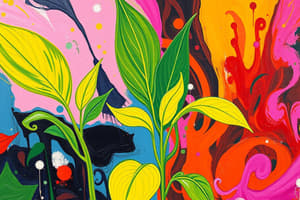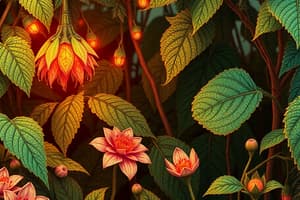Podcast
Questions and Answers
What is the term used to describe the directional growth movement of a plant due to an external stimulus?
What is the term used to describe the directional growth movement of a plant due to an external stimulus?
- Phototropic
- Endocytic
- Tropic (correct)
- Chemotropic
Which plant part shows negative phototropism, bending away from light?
Which plant part shows negative phototropism, bending away from light?
- Roots (correct)
- Shoots
- Pollen tubes
- Tendrils
Which phytohormone is responsible for promoting cell division and is mostly present in fruits and seeds?
Which phytohormone is responsible for promoting cell division and is mostly present in fruits and seeds?
- Abscisic acid
- Cytokinins (correct)
- Gibberellins
- Auxin
What happens when there is a deficiency of iodine, which is essential for the synthesis of thyroxin?
What happens when there is a deficiency of iodine, which is essential for the synthesis of thyroxin?
How do tendrils respond when part of them is in contact with a surface compared to the part away from the surface?
How do tendrils respond when part of them is in contact with a surface compared to the part away from the surface?
Which hormone helps plant cells grow longer in response to light stimuli?
Which hormone helps plant cells grow longer in response to light stimuli?
What is the primary purpose of putting vaseline on leaves of plants?
What is the primary purpose of putting vaseline on leaves of plants?
Which of these is a key adaptation of plant leaves for photosynthesis?
Which of these is a key adaptation of plant leaves for photosynthesis?
Why do fishes die without water?
Why do fishes die without water?
Which tissue allows water movement in plants due to differences in ion concentrations?
Which tissue allows water movement in plants due to differences in ion concentrations?
How do Yeast, mushroom, and bread mould obtain their food?
How do Yeast, mushroom, and bread mould obtain their food?
What is the function of tendrils in plants?
What is the function of tendrils in plants?
Which part of the plant is responsible for attracting pollen during pollination?
Which part of the plant is responsible for attracting pollen during pollination?
In plant reproduction, what is the function of the style?
In plant reproduction, what is the function of the style?
What is the male gamete in plant reproduction known as?
What is the male gamete in plant reproduction known as?
Which part of the pistil contains the egg cells in a plant?
Which part of the pistil contains the egg cells in a plant?
What is the advantage of self-pollination in plants?
What is the advantage of self-pollination in plants?
Which method of pollination results in more variation due to pollen transfer between different plants?
Which method of pollination results in more variation due to pollen transfer between different plants?
Flashcards are hidden until you start studying
Study Notes
Plant Growth and Development
- Tendrils circle around and cling to objects when they make contact, due to slower growth on the contact side.
- Tropic means directional growth in response to an external stimulus.
Phototropism
- Shoots are positively phototropic, bending towards light.
- Roots are negatively phototropic, bending away from light.
Chemical Communication
- Electrical impulses are limited to cells connected to nervous tissue.
- Phytohormones are chemical substances that regulate growth, development, and cell division.
- Examples of phytohormones include auxin, cytokinin, and gibberellins.
Auxins
- Auxin helps cells grow longer in response to light.
- It is synthesized at the shoot tip and diffuses towards the shady side, stimulating growth.
- This causes the plant to bend towards light.
Gibberellins and Cytokinins
- Gibberellins promote stem growth.
- Cytokinins promote cell division, present mostly in fruits and seeds.
Abscisic Acid (ABA)
- ABA inhibits growth, causing wilting of leaves.
Endocrine System
- Thyroxin is produced by the thyroid gland, regulating metabolism for body growth.
- Iodine is essential for thyroxin synthesis; deficiency leads to goitre.
Tissue Culture
- Tissue culture involves using small tissues or cells from the growing tip of a plant to produce a new plant in artificial conditions.
- A group of cells called a callus is formed.
Sexual Reproduction
- During sexual reproduction, two germ cells fuse to form a zygote, giving rise to a new individual.
- Meiosis is a special cell division that results in halving of chromosomes, which is restored after fusion.
Plant Reproductive Parts
- Stamen is the male reproductive part.
- Pistil is the female reproductive part, consisting of ovary, style, and stigma.
- Ovary contains ovules with egg cells.
- Style is the middle elongated part that joins the stigma and ovary.
- Stigma is the terminal part that attracts pollen.
Pollination and Fertilization
- Pollination is the transfer of pollen to the stigma.
- Fertilization occurs when the pollen travels through the style to reach the ovary.
- Zygote goes through divisions to form an embryo.
Self-Pollination vs Cross-Pollination
- Self-pollination: transfer of pollen within the same flower or different flower of the same plant.
- Advantages: preserves parental characters, disadvantages: leads to expression of genetic defects.
- Cross-pollination: transfer of pollen to another plant.
- Advantages: more variation, disadvantages: depends on external agents.
Plant Water Conducting Tissues
- Two water conducting tissues in plants are xylem vessels and xylem tracheids.
- Water enters xylem at the roots, where cells actively take up ions, creating a concentration difference.
Plant Energy Needs
- Plants have low energy needs due to their sedentary nature and high proportion of dead cells in many tissues.
Adaptations for Photosynthesis
- Flat leaf surface allows for greater exposure to light.
- Presence of chlorophyll traps sunlight.
- Presence of stomata on the leaf surface enables easy transpiration.
- Numerous stomata allow for more carbon dioxide uptake.
Studying That Suits You
Use AI to generate personalized quizzes and flashcards to suit your learning preferences.




